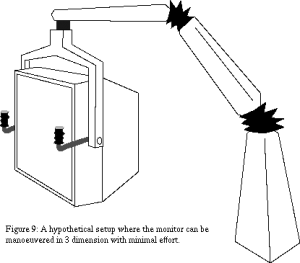In technology, use model and interface metaphors exert a powerful influence on the rhetorical framing innovators adopt for their work. These metaphors can become entrenched schools of thought in product and experience design, making it difficult to imagine alternative approaches. Consider the longevity of the desktop metaphor for personal computing – it has been more than 35 years since the original Xerox PARC Alto, and we are still looking at desktops on many of our screens.
Similarly, the idea of electronic newspapers has been around since at least the 1970s, and now that the print newspaper industry is in dire straits we are seeing that notion thrown around rather more freqently. For example, LG Display is currently showing off an impressive lab prototype of a 19†flexible e-paper display that is 0.3mm thick and weighs just 4 ounces. The prototype measures 40x25cm or around 16×10 inches, making it about the size of a small tabloid newspaper. LG are touting it as “optimized for an e-newspaper and able to convey the feeling of reading an actual newspaper”
As I see it, there’s a fundamental problem with attempts to transplant the design of physical newspapers into an “electronic newspaper” interaction metaphor. The design of print newspapers, and our interaction with them – where, when, what and how we read – arises from the intrinsic properties of the medium. The size of pages, the multicolumn tiled layout, the length of stories, the variety and separation of sections, advertising, subscriptions, deadlines, distribution, local geographic focus, national syndication, editorial viewpoint – all of these factors evolved to their current state largely due to the physical properties and economics of paper. When you remove the paper and substitute a dynamic networked display appliance, you have changed the underlying properties and constraints so radically that the entire newspaper metaphor collapses.
Furthermore, as Clay Shirky and many others have observed, the Internet has spawned a host of disaggregated alternatives to all of the major functions of print newspapers. From online news sites, blogs and social media to Craigslist, Google, spot.us and the Sunlight Foundation, we are evolving new structures, business logic and user experiences based on the properties and economics of connected world technologies. As Shirky wrote in March 2009:
Round and round this goes, with the people committed to saving newspapers demanding to know “If the old model is broken, what will work in its place?” To which the answer is: Nothing. Nothing will work. There is no general model for newspapers to replace the one the internet just broke.
With the old economics destroyed, organizational forms perfected for industrial production have to be replaced with structures optimized for digital data. It makes increasingly less sense even to talk about a publishing industry, because the core problem publishing solves — the incredible difficulty, complexity, and expense of making something available to the public — has stopped being a problem.
When I see electronic versions of print newspapers being sold for Amazon’s Kindle, demonstrated on the Plastic Logic QUE, and mocked up in demos like LG’s flexible plastic e-paper, I see designers and marketers indulging in nostalgia for a bygone era. Newspapers as we know them are pretty much dead. Let’s bury the electronic newspaper metaphor with them.
Postscript:
While researching this post I came across Hakon Lie’s 1990 MSc thesis from the MIT Media Lab, titled The Electronic Broadsheet – all the news that fits the display. Lie describes the design and implementation of a broadsheet-sized electronic newspaper on a large high resolution display. Although some of the leading edge technology from 1990 (pre-WWW, pre-flat panel monitors) seems quaint now, Lie’s overview of the Newspaper Metaphor remains relevant and worth reviewing. Lie sought to maintain the best qualities and practices of newspaper reading while augmenting them with the affordances of networked digital media, reifying the whole into a new kind of newspaper. At the time, he did not anticipate the breadth and depth of disruption that would begin in just a few years with the advent of the web. Of course Lie went on to develop CSS in 1994, demonstrating somewhat greater adaptability than the newspaper industry he sought to transform.
Tags: Clay Shirky, electronic newspaper, experience design, interface metaphor



[…] This post was mentioned on Twitter by Chris Grayson, Gene Becker. Gene Becker said: let’s bury the electronic newspaper « the connected world http://j.mp/5eMynX #in #fb […]
Good points. The one thing you didn’t say, which may be because you don’t feel this way, is that the printed newspaper metaphor is crap in and of itself. Digital screens allow us to organize and manipulate information in whatever way presents the information best, while newspapers rely on comparatively unwieldy folding and column formatting.
I’m sure there will still be newspapers, both print and electronic, many people are too familiar with it to just let it go. Besides, some people still drive cars that look remarkably like Model T’s, but we don’t think that design is worth preserving. We consider these people nostalgic eccentrics, which is exactly what we’ll come to think of newspaper readers as.
Thanks Will. I’m sure newspapers will be around for a good long time, although they will lose much of their cultural primacy (if they haven’t already). I actually really enjoy the ritual and the familiar structural elements of the daily fishwrap, I just wish it wasn’t so, um, dead.
While I agree that each new medium has its own affordances, character, and business models, I don’t think it makes sense to throw everything that’s worked about newspapers just because “the internet changes everything”. There are many reasons for certain page layout approaches that have more to do with how people read than any particular medium (and most websites are really bad in this respect). Likewise, publishers to not exist solely to print and distribute paper – they curate, edit, and (sometimes) actually pay journalists to perform quality, in-depth reporting.
So I think it’s really premature to write-off the whole notion of page-layout, journalism and publishing. Film adapted many things from the stage, as television did from film. The more critical questions are:
1) what are the new affordances of something like large-format e-paper – which is probably more different from web pages than paper?
2) what are the business models that preserve what’s good about the traditional newspaper?
Philip, thanks for your thoughtful comment. By no means am I advocating throwing out page layout, journalism, or quality content. I’m simply tired of seeing concepts that worked for physical newspapers transferred unquestioned to electronic formats. Your questions seem like the right ones: what value and experiences are uniquely suited to networked systems, and what business models are appropriate?
I’d also venture the answers are different for desktop, mobile, public ambient screens, and yes 19″ plastic broadsheets. Full employment act for information/interface/experience designers.